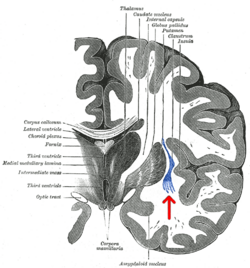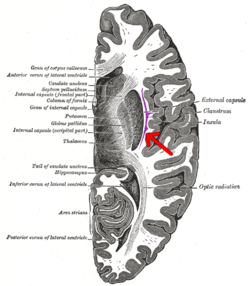
Back عائق (طب) Arabic Claustrum Danish Claustrum German Claustrum Spanish Claustrum French קלאוסטרום HE Claustro Italian 前障 Japanese Ми шарбақ Kazakh 담장 Korean
| Claustrum | |
|---|---|
 Coronal section of human cerebrum. The claustrum is indicated by the arrow. | |
 Transverse section of human cerebrum. The claustrum is indicated by the arrow. | |
| Details | |
| Part of | Brain |
| Artery | Middle cerebral artery |
| Identifiers | |
| MeSH | D000079482 |
| NeuroNames | 252 |
| NeuroLex ID | birnlex_1522 |
| TA98 | A14.1.09.421 |
| TA2 | 5535 |
| FMA | 67440 |
| Anatomical terms of neuroanatomy | |
The claustrum (Latin, meaning "to close" or "to shut") is a thin sheet of neurons and supporting glial cells, that connects to the cerebral cortex and subcortical regions including the amygdala, hippocampus and thalamus of the brain.[1][2] It is located between the insular cortex laterally and the putamen medially, encased by the extreme and external capsules respectively.[3][1][4] Blood to the claustrum is supplied by the middle cerebral artery.[1] It is considered to be the most densely connected structure in the brain, and thus hypothesized to allow for the integration of various cortical inputs such as vision, sound and touch, into one experience.[4][5] Other hypotheses suggest that the claustrum plays a role in salience processing, to direct attention towards the most behaviorally relevant stimuli amongst the background noise.[6] The claustrum is difficult to study given the limited number of individuals with claustral lesions and the poor resolution of neuroimaging.
The claustrum is made up of various cell types differing in size, shape and neurochemical composition. Five cell types exist, and a majority of these cells resemble pyramidal neurons found in the cortex.[7][8] Within the claustrum, there is no laminar organization of cell types as in the cortical layers, and the cell bodies can be a pyramidal, fusiform or circular.[1] The principal cell type found in the claustrum is the Golgi type I neuron, which is a large cell with dendrites covered in spines.[9][8]
Through interhemispheric connections, the claustrum is believed to play a role in synchronizing activity in widely separated, but functionally related, parts of the brain (e.g. frontal eye fields and visual cortex).[1][10][11] As such, the claustrum is thought to play a role in combining different information modalities potentially to support consciousness itself.[10][12] Another proposed function of the claustrum is to differentiate between relevant and irrelevant information so that the latter can be ignored.[5][12][13] Cortical components of consciousness include the fronto-parietal cortex, cingulate and precuneus. Due to the claustrum's widespread connectivity to these areas, it is suggested that it may play a role in both attention and consciousness. The neural networks that mediate sustained attention and consciousness send inputs to the claustrum, and one case report in humans suggests that electrical stimulation near the claustrum reversably disrupted the patients conscious state.[14]
- ^ a b c d e Crick FC, Koch C (June 2005). "What is the function of the claustrum?". Philosophical Transactions of the Royal Society of London. Series B, Biological Sciences. 360 (1458): 1271–9. doi:10.1098/rstb.2005.1661. PMC 1569501. PMID 16147522.
- ^ Smith JB, Lee AK, Jackson J (2020). "The claustrum". Current Biology. 30 (23): R1401–R1406. doi:10.1016/j.cub.2020.09.069. PMID 33290700. S2CID 227507231.
- ^ Smith JB, Alloway KD, Hof PR, Orman R, Reser DH, Watakabe A, Watson GDR (February 2019). "The relationship between the claustrum and endopiriform nucleus: A perspective towards consensus on cross-species homology". J Comp Neurol. 527 (2): 476–499. doi:10.1002/cne.24537. PMC 6421118. PMID 30225888.
- ^ a b Chau A, Salazar AM, Krueger F, Cristofori I, Grafman J (November 2015). "The effect of claustrum lesions on human consciousness and recovery of function". Consciousness and Cognition. 36: 256–64. doi:10.1016/j.concog.2015.06.017. PMID 26186439. S2CID 46139982.
- ^ a b Brown SP, Mathur BN, Olsen SR, Luppi PH, Bickford ME, Citri A (November 2017). "New Breakthroughs in Understanding the Role of Functional Interactions between the Neocortex and the Claustrum". The Journal of Neuroscience. 37 (45): 10877–10881. doi:10.1523/JNEUROSCI.1837-17.2017. PMC 5678020. PMID 29118217.
- ^ Smith JB, Watson G, Liang Z, Liu Y, Zhang N, Alloway KD (2020). "A Role for the Claustrum in Salience Processing?". Frontiers in Neuroanatomy. 13 (64): R1401–R1406. doi:10.3389/fnana.2019.00064. PMC 6594418. PMID 31275119.
- ^ Braak H, Braak E (1982). "Neuronal types in the claustrum of man". Anatomy and Embryology. 163 (4): 447–60. doi:10.1007/BF00305558. PMID 7091711. S2CID 7566723.
- ^ a b Nikolenko VN, Rizaeva NA, Beeraka NM, Oganesyan MV, Kudryashova VA, Dubovets AA, Borminskaya ID, Bulygin KV, Sinelnikov MY, Aliev G (July 2021). "The mystery of claustral neural circuits and recent updates on its role in neurodegenerative pathology". Behav Brain Funct. 17 (1): 8. doi:10.1186/s12993-021-00181-1. PMC 8261917. PMID 34233707.
- ^ Mathur BN (2014). "The claustrum in review". Front Syst Neurosci. 8: 48. doi:10.3389/fnsys.2014.00048. PMC 3983483. PMID 24772070.
- ^ a b Smith JB, Liang Z, Watson GD, Alloway KD, Zhang N (July 2017). "Interhemispheric resting-state functional connectivity of the claustrum in the awake and anesthetized states". Brain Structure & Function. 222 (5): 2041–2058. doi:10.1007/s00429-016-1323-9. PMC 5382132. PMID 27714529.
- ^ Stevens CF (June 2005). "Consciousness: Crick and the claustrum". Nature. 435 (7045): 1040–1. Bibcode:2005Natur.435.1040S. doi:10.1038/4351040a. PMID 15973394. S2CID 5402518.
- ^ a b Torgerson CM, Irimia A, Goh SY, Van Horn JD (March 2015). "The DTI connectivity of the human claustrum". Human Brain Mapping. 36 (3): 827–38. doi:10.1002/hbm.22667. PMC 4324054. PMID 25339630.
- ^ Goll Y, Atlan G, Citri A (August 2015). "Attention: the claustrum". Trends in Neurosciences. 38 (8): 486–95. doi:10.1016/j.tins.2015.05.006. PMID 26116988. S2CID 38353825.
- ^ Koubeissi MZ, Bartolomei F, Beltagy A, Picard F (August 2014). "Electrical stimulation of a small brain area reversibly disrupts consciousness". Epilepsy & Behavior. 37: 32–5. doi:10.1016/j.yebeh.2014.05.027. PMID 24967698. S2CID 8368944.
© MMXXIII Rich X Search. We shall prevail. All rights reserved. Rich X Search